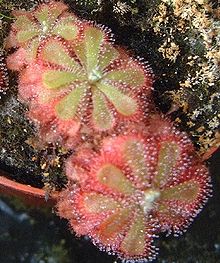Drosera aliciae
| Drosera aliciae | ||||||||||||
|---|---|---|---|---|---|---|---|---|---|---|---|---|

Drosera aliciae , inflorescence |
||||||||||||
| Systematics | ||||||||||||
|
||||||||||||
| Scientific name | ||||||||||||
| Drosera aliciae | ||||||||||||
| Raym-Hamet |
Drosera aliciae is a carnivorous plant of the genus sundew ( Drosera ).
description
Drosera aliciae has a compact, down-to-earth, dense rosette and measures around 5 to 6 cm in diameter. With age, the plant forms a trunk from which further rosettes can sprout laterally. The plants have a single, slightly branched only in the lower half, up to 10 cm long taproot .
leaves
The approximately 30 sessile leaves are up to 1.2 cm wide and (stretched) up to 3 cm long and 7 mm wide and hairy on their underside. The leaves of a plant are very regular in size, shape and color.
In stronger sunlight, the leaves quickly turn deep red, which is believed to increase their attractiveness for prey. The stipules are egg-shaped, up to 5 millimeters long and divided into three parts.
Flowers and fruits
Drosera aliciae blooms from December to January. The upright inflorescence can be 15 to 40 cm high, at its end there are two to twelve autogamous single flowers arranged in a one-sided coil , each open for one day . The flower stalks are up to 8 mm long, the broad, egg-shaped sepals up to 5 mm long. The purple, broad, inverted-egg-shaped petals are up to 10 mm long, the stamens are flattened. The stylus is already divided two or three times from the base, the scar is widened at its end point.
The capsule fruits are egg-shaped and contain numerous fine, elongated spindle-shaped seeds, the shell of which elongates at both ends and is between 0.5 and 0.6 mm long and a maximum of 0.1 mm wide.
Chromosome number
The number of chromosomes is 2n = 40 or 80.
distribution
Drosera aliciae is native from the southwest to the east of South Africa , it is a floral element of the Capensis . It likes full sun, wet locations with sandy soils, but can also be found on peat .
Systematics
The species is closely related to a number of other species that it closely resembles, such as Drosera slackii , Drosera dielsiana , Drosera esterhuysenae and Drosera natalensis .
use
The simple reproduction and undemanding culture makes Drosera aliciae, as an ornamental plant, probably the most commercially important sundew next to the Cape sundew .
literature
- Anna Amelia Obermeyer: Droseraceae. In: The Flora of Southern Africa. Volume 13: Cruciferae, Capparaceae, Resedaceae, Moringaceae, Droseraceae, Roridulaceae, Podosfemaceae, Hydrostachyaceae. Botanical Research Institute - Department of Agricultural Technical Services - Republic of South Africa, Pretoria 1970, pp. 187-201.
- Wilhelm Barthlott , Stefan Porembski, Rüdiger Seine, Inge Theisen: Carnivores. Biology and culture of carnivorous plants. Ulmer, Stuttgart 2004, ISBN 3-8001-4144-2 .
Individual evidence
- ^ Drosera aliciae at Tropicos.org. In: IPCN Chromosome Reports . Missouri Botanical Garden, St. Louis
